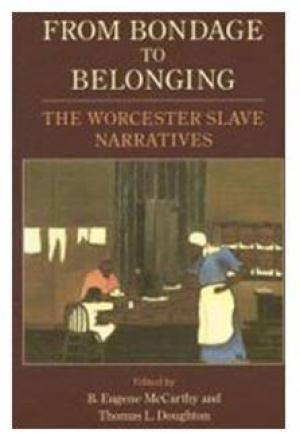19th WWHP Annual Meeting

Following the short business meeting, a program will be presented by B. Eugene McCarthy and Thomas L. Doughton, authors of From Bondage to Belonging. McCarthy and Doughton collected and edited the narratives of eight former slaves who made their way north and settled or spent part of their life in Worcester. The narratives are presented chronologically from 1842 to 1895. A book signing follows.
From Bondage to Belonging: The Worcester Slave Narratives, reviewed by Margaret Watson, WWHP Steering Committee member.
For their work, From Bondage to Belonging, B. Eugene McCarthy and Thomas L. Doughton collected and edited the narratives of eight former slaves who made their way north and settled or spent part of their life in Worcester, Massachusetts.
The narratives are presented chronologically from 1842 to 1895. The headnote to each narrative provides details of the writer’s life not found in the narrative it-self. These details were provided by Thomas Doughton who researched the history of black Worcester. As a result, this work is a major contribution to our understanding of Worcester’s development into modern times. B. Eugene McCarthy provides the literary commentary on the narratives and describes how the narratives work, distinguishing them from one another.
Hundreds of slave narratives were published prior to the Civil War; only 67 appeared following that war. Of the eight slave narratives in From Bondage to Belonging, four were written prior to the Civil War and four following that conflict. We find that by 1861, approximately 175-200 African Americans lived in Worcester and this number expanded thereafter. According to an anonymous letter written to the "Weekly Anglo-American" published in April of 1861, the African Americans in Worcester were painters, harness makers, shoe-makers, barbers, hairdressers, upholsterers, job cart men, paper hangers, and house cleaners. One was a teacher of music. There was also a literary society of about twenty members, both men and women who met weekly.
Worcester by mid-century was an energetic center of black activity. Former slaves, their children, and grandchildren lived in clustered communities. Members of the white community in Worcester hired blacks and interacted with members of the black community. For example, the first Stephen Salisbury hired a black day-laborer named Worcester Winslow to assist in the building of what is now the Worcester Historical Museum. Black children attended schools with white children. In 1846 the Zion Methodist Society organized to create the African Zion Episcopal Church in Worcester. Also by 1861 Worcester had established the Worcester Anti-Slavery Society.
The eight accounts are autobiographical as the writ-ers describe their passage from slavery to freedom. Yet each voice is different, as the perspectives of each varies according to his or her experiences and priorities. Seven of the narratives were written by men, and one narrative by a woman, Bethany Veney.
Bethany Veney, a slave born in Virginia, was purchased by two individuals from Rhode Island and then set free. She traveled to Rhode Island and was separated from her husband and daughter. After moving with her employer to Worcester, she decided to remain here. Ms.Veney was a founding member of the African Methodist Episcopal Church which was organized in 1867. This AME church was the city’s second black Congregation. Bethany worked as a domestic and was able to purchase a home on what is now Winfield Street. Several hundred residents of Worcester today are descended from Bethany Veney, a woman well respected in her life and re-membered by many.
In their work From Bondage to Belonging, McCarthy and Doughton present the individual voices of eight former slaves with scholarly integrity and great sensitivity. This collection covers an important chapter in the history of Worcester, an account often overlooked or ignored.

